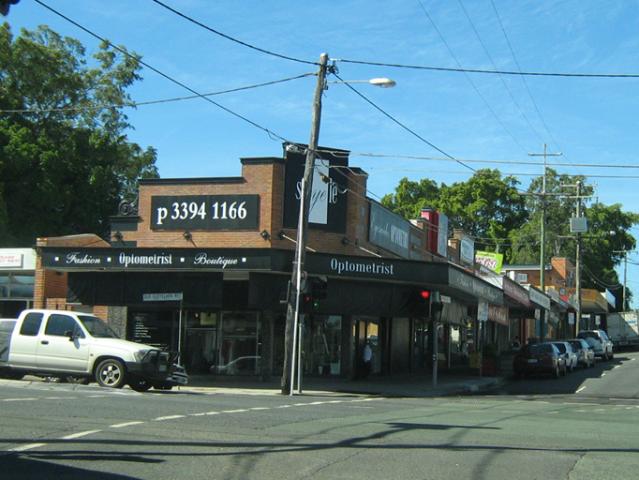Addresses
Type of place
Shop/s
Period
Interwar 1919-1939
Style
Free Style
Addresses
Type of place
Shop/s
Period
Interwar 1919-1939
Style
Free Style
The set of three brick shops on the corner of Cavendish and Old Cleveland Roads was built in 1927. Originally a grocery store in the late nineteenth century, known as Faust’s Grocery, the corner site building was replaced by the brick building designed by E. P. Trewern. The interwar period in Coorparoo was one of increased development reflective of the population growth in the area, this set of shops demonstrates this.
Also known as
Faust's Grocery
Lot plan
L1_RP124150
Key dates
Local Heritage Place Since —
Date of Citation —
Construction
Walls: Face brickPeople/associations
Eric Percival Trewern (Architect);W. R. Gaskell and Son (Builder)
Criterion for listing
(A) Historical; (E) AestheticInteractive mapping
Also known as
Faust's Grocery
Lot plan
L1_RP124150
Key dates
Local Heritage Place Since —
Date of Citation —
Construction
Walls: Face brickPeople/associations
Eric Percival Trewern (Architect);W. R. Gaskell and Son (Builder)
Criterion for listing
(A) Historical; (E) AestheticInteractive mapping
History
The initial settlement of the area now known as Coorparoo was relatively slow. Coorparoo land sales occurred from 1856, gradually development occurred with mainly farmers and land speculators purchasing land at these early sales. By 1888, the locality had a population in excess of 2,000 people in over 550 homes. The population growth in the area saw ribbon development along the main transport arteries of Logan Road and Old Cleveland Road; pocket development in areas such as Stones Corner; with the wealthier residents living on the hill tops especially along the Cavendish Road ridgeline.
From the mid 1870s the population of Brisbane increased markedly and a rise in residential settlement began to occur. Brisbane’s population had grown to 47, 000 by 1881. It was during the 1880s that the greatest changes to the residential settlement patterns occurred. This was due to several factors including an expanding economy, expansion of infrastructure including extended tram and train services, improved communication systems, and an increase in immigration to Brisbane. By 1891 Brisbane’s population had increased to over 100, 000.
By the 1890s, the Stones Corner and Coorparoo area included a socio-economic mix that ranged from farmers to politicians. These included Frederick Brentnall M.L.C., James Stodart M.L.A. and Walter Henry Barnes M.L.A., business men such as Nathaniel Lade, James Hipwood and Reuben Nicklin and important public servants such as Edward Deshon C.M.G., Reginald Mulholland King, James Evan Burstall and T.W. Connah. Coorparoo, while not distant from the city, was a semi-rural area until the 1910s. Then the population began to increase rapidly due to the extension of the tramline to Stones Corner in 1915.
One of the important Coorparoo roads became Cavendish Road with its plethora of hilltops. This road developed into an elite address for a small number of wealthy local residents. By the 1890s, there were six such families living along Cavendish Road between Old Cleveland and Chatsworth Roads and in 1914 this number had increased to ten. They built their large houses on acreage sites, employed domestic staff and had such amenities as kitchen gardens, orchards, fowl houses and tennis courts.
The interwar period heralded a period both of residential expansion and developmental consolidation in Brisbane. With the extension of tramlines, suburbs such as Greenslopes, Camp Hill and Coorparoo experienced major increases in residential development throughout the 1920s and 1930s.
The set of three brick shops situated at the corner of Cavendish and Old Cleveland Roads reflects the growing residential popularity of the suburb of Coorparoo in the interwar period and the increased need for retail facilities. In 1915 Peter Joseph Faust established a grocery store on the corner site and began a commercial tradition. In 1926 the property was sold to David Young. Aware of the commercial potential of the corner, Young’s plans were for the building of a set of shops to maximise his investment returns. In May 1927 plans were approved for the construction of a set of three brick shops on the corner. The building was designed by renowned Brisbane interwar architect, E. P. Trewern and built by W. R. Gaskell and Son.
Victorian trained Eric Percival Trewern established his Brisbane architectural practice in 1920 at an address in Queen Street, Brisbane. The practice continued until Trewern’s death in 1959. The height of his design success occurred in the interwar period and he is renowned for his innovative designs incorporating the Spanish Mission and the Old English/Tudor revival style in residential and commercial architecture. Amongst his finest residential designs is the New Farm house “Santa Barbara” that is considered the best example of the Spanish Mission style in Brisbane. Trewern designed many commercial buildings in central Brisbane many of which no longer exist. One important extant building is the Inchcolm Professional Chambers on Wickham Terrace. Trewern was an active member of many prestigious architectural societies in the pursuit of improving professional architectural standards in Queensland.
In 1929 three businesses were listed at the address; on the very corner was the Coorparoo Butchery, then Tomlinson’s store, and Mrs. Crowley’s confectionary shop. The intact brick set of shops have continued their original retail use throughout the twentieth and into the twenty-first century and play an important contributing role in Coorparoo’s history.
Statement of significance
Relevant assessment criteria
This is a place of local heritage significance and meets one or more of the local heritage criteria under the Heritage planning scheme policy of the Brisbane City Plan 2014. It is significant because:
References
-
Historic Titles, Department of Natural Resources and Water
-
Queensland Post Office Directories
-
Metropolitan Water and Sewage Survey Maps, 1949
-
Watson, Donald and Judith McKay. A Directory of Queensland Architects to 1940. (St. Lucia: U of Q Press, 1984)
-
Coorparoo, Stones Corner Centenary, 1856 – 1956, Printed by The Courier Mail, 1956
Citation prepared by — Brisbane City Council (page revised June 2022)

